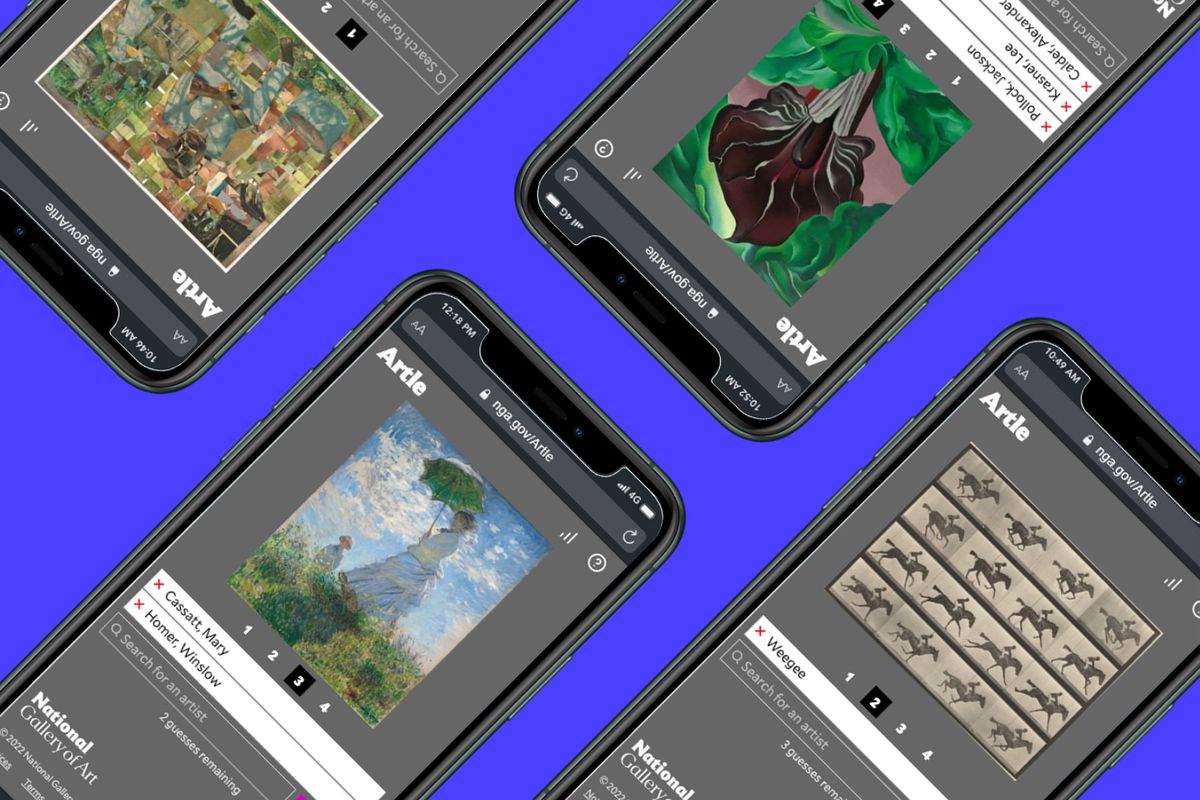Wordle fan? The National Gallery of Art has launched a copycat

Summer Brennan can recognize a Vincent van Gogh painting by its wispy, vibrant brushstrokes. A series of loopy spirals or spindly legs? That’s probably Louise Bourgeois.
But after a few days of playing Artle, Brennan, a writer based in Paris, began to notice some holes in her art knowledge. For 30 years, she has indulged her love of visual arts by visiting galleries, reading books and attending shows. So when she couldn’t identify a piece by French photographer Eugène Atget, it felt like an embarrassing lapse.
“It does give you some self-awareness when you realize that all the artists you know right away are like White 19th-century artists, that maybe it’s time to expand some of your art appreciation,” Brennan said.
One of the latest Wordle copycats challenges players not with letters, but with images plucked from the National Gallery of Art. The popular daily word game, which was purchased by the New York Times for seven figures in January, has sparked dozens of spinoffs: Squabble (a Wordle battle royal), Heardle (for the musically minded), and even Lewdle (for profanity experts).
Artle begins by showing players a piece of art – a painting, photograph or sculpture – from the National Gallery of Art’s 150,000-piece collection, including whimsical paintings by Georgia O’Keeffe and somber Roy DeCarava photographs. Players have four chances to guess the artist. Unlike Wordle, there are no hints, although the art becomes progressively easier to identify as players strike out. Players can then share their results with friends through text messages or on social media.
Mary Gregory, an art critic based in New York, began playing Artle as soon as it launched last month and it’s now become a ritual. Every day, Gregory and her husband return to the gallery’s Artle website to test their art aptitude and extend their untouched winning streak.
“It’s fun. It’s a little challenge. And, you know what? If you get it wrong at the end, they tell you who it was,” she said. “These are in the collection of the National Gallery, and the National Gallery belongs to everybody.”
Steven Garbarino, a product manager at the gallery, began developing the game after noticing that people were searching for “Art Wordle” online but that no such game existed. It was the worst possible time. In late March, the museum’s staff was busy with “Afro-Atlantic Histories,” the gallery’s largest exhibition since the start of the pandemic. Garbarino worried that launching a gaming app would be seen as a distraction.
To his surprise, National Gallery of Art Director Kaywin Feldman quickly jumped on board. It took little more than a month to build the game, and it quickly began attracting an audience, with players in nearly every country. It has been played more than 1 million times and has 30,000 daily players. The game has increased traffic to the museum’s website by 125 percent.
“You can catch a little bit of lightning in a bottle and see cascading results,” Garbarino said. “We don’t have to spend 12 months developing a huge strategy and positioning plan. We can build something small (like Artle) that engages the audience.”
Projects such as Artle reflect a new vision for the National Gallery of Art: a desire to quickly reach new, more diverse audiences. Since being named director in 2019, Feldman has updated the museum’s mission statement and priorities. The product management team, which developed the game, has doubled in size, including adding more software engineers and digital consultants under Feldman’s leadership. “The bulk of our funding comes from the American taxpayers, so we owe it to them to give them the greatest art experience they can have. And the nation is a very diverse place. We want to focus on the great richness of the diversity of the American people and better reflect the nation,” Feldman said in an interview with Washingtonian last year.
The team worked closely with the gallery’s education department to choose a mix of famous, easily identifiable art and more obscure pieces. Within the game, for example, Georgia O’Keeffe paintings are considered easy to identify, while those by James McNeill Whistler are a little more difficult. Meanwhile, a piece by Elizabeth Catlett, a Black sculptor and graphic artist, is considered difficult to pick out.
The gallery wants the artists displayed in the game to reflect a diversity of races and gender, Garbarino said. “Often some of the lowest success rates are on artists of diverse backgrounds, artists of color or women artists,” he said.
It’s a challenge. Of the 157,553 objects in the gallery’s collection, only 2.3 percent are by nonwhite artists, and 8.1 percent are by female artists. In the first 45 days of “Artle,” 17.8 percent of the objects used in the game were by nonwhite artists and 22.2 percent were by female artists.
“It’s a fine balance between bringing up artists that we think should be having a higher priority among the public while maintaining that ease of introduction to the game,” Garbarino said. “If it happens to be two days in a row where it’s a dead white man and someone is like, ‘Hey, every time I come here, it’s only a dead white man.’ It’s like, no, if you look at the broad spectrum of all the artists, it’s much more diverse. But it’s difficult to communicate that in one day.”
The well of famous artists will soon run dry, Garbarino said, and “Artle” will have to begin repeating artists or introducing its players to more unfamiliar names.
That could drive away players like Brennan’s husband who, she said, calls Artle “torture” and often simply offers Picasso as the answer to every image to end the game quickly.
It turns out Artle may not be for everyone.